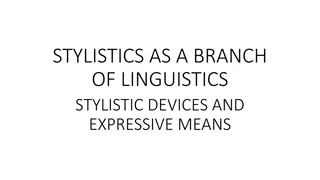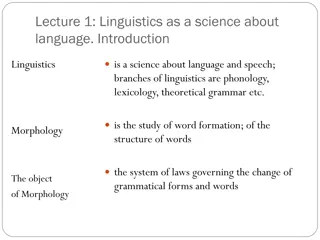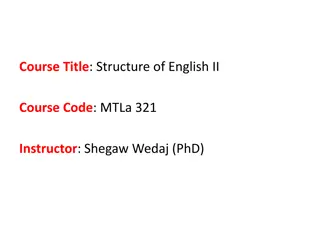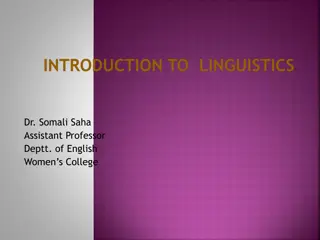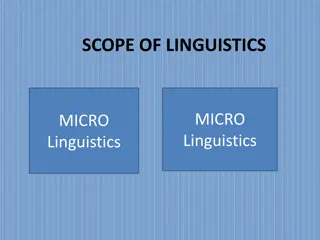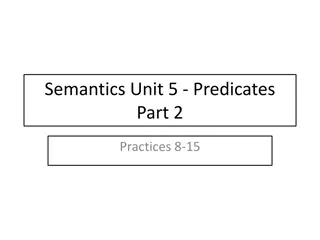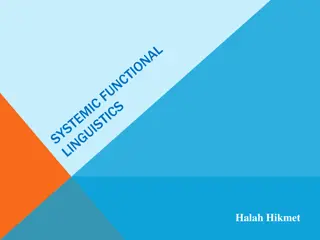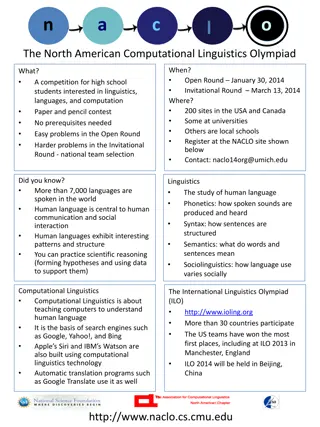
Linguistics in English Language Teaching (ELT)
Explore the essentials of linguistics in ELT, covering phonetics, morphology, syntax, semantics, pragmatics, sociolinguistics, psycholinguistics, SLA, and applied linguistics. Enhance your teaching with insights into language structure, meaning, and use.
Download Presentation

Please find below an Image/Link to download the presentation.
The content on the website is provided AS IS for your information and personal use only. It may not be sold, licensed, or shared on other websites without obtaining consent from the author. If you encounter any issues during the download, it is possible that the publisher has removed the file from their server.
You are allowed to download the files provided on this website for personal or commercial use, subject to the condition that they are used lawfully. All files are the property of their respective owners.
The content on the website is provided AS IS for your information and personal use only. It may not be sold, licensed, or shared on other websites without obtaining consent from the author.
E N D
Presentation Transcript
ELTE 201 LINGUISTICS Dr Afet GUNEY
What is Linguistics? The study of linguistics in English Language Teaching (ELT) refers to the systematic examination of language and its structure to inform and enhance the teaching and learning of English. It involves several key areas:
What is Linguistics? 1. Phonetics and Phonology: Understanding the sounds of English, how they are produced (articulatory phonetics), perceived (auditory phonetics), and organized (phonology). This knowledge helps teachers improve students' pronunciation and listening skills. 2. Morphology: Analyzing the structure of words and how they are formed from smaller units called morphemes (e.g., roots, prefixes, suffixes). This aids in teaching vocabulary, word formation, and understanding spelling patterns.
What is Linguistics? 3. Syntax: Studying sentence structure and the rules that govern the arrangement of words in sentences. This area helps teachers explain grammatical rules and construct correct and meaningful sentences. 4. Semantics: Understanding meaning in language, including how words and sentences convey meaning, and how context affects interpretation. This is crucial for teaching vocabulary, reading comprehension, and effective communication.
What is Linguistics? 5. Pragmatics: Examining how language is used in social contexts to achieve specific purposes, such as making requests, giving orders, or striking up a conversation. This knowledge is essential for teaching functional language use and conversational skills. 6. Sociolinguistics: Investigating how social factors (e.g., age, gender, ethnicity, social class) influence language use. It helps teachers understand language variation and address the diverse linguistic backgrounds of learners. (stopped here at Group 2)
What is Linguistics? 7. Psycholinguistics: Exploring the cognitive processes involved in language acquisition and use. This informs teaching strategies that align with how the brain processes language, aiding memory retention and problem-solving. 8. Second Language Acquisition (SLA): Studying how people learn a second language, including the stages of acquisition, influencing factors, and effective pedagogy. It helps in developing teaching methodologies and materials that facilitate language learning.
What is Linguistics? 9. Applied Linguistics: Directly applying linguistic theory to solve real- world problems in language education, policy, and technology. This bridges the gap between theory and practice in a classroom setting.
So, By integrating these aspects of linguistics into ELT, educators can develop a comprehensive understanding of language, which enables them to design effective teaching strategies, create rigorous assessment tools, and provide targeted support to learners. This holistic approach fosters a richer and more nuanced learning experience for students.
Sample Footer Text What is LANGUAGE? This Photo by Unknown Author is licensed under CC BY-ND 3/20/2025 9
Geertzs view (1975, p.9) languag e and other semiotic systems are culture linguisti c code; social act languag e is a From a linguisti c perspect ive, languag e is a languag e is a perspect ive, process What is LANGUAGE? From a sociolin guistic perspect ive nguistic s cognitiv e accordi ng to the psycholi
What is LANGUAGE? is an intercultu ral process (in Luissier, 2011, p.36). Language According to Vygotsky (1962) and Bourdieu (1982) ,
What is LANGUAGE? Language acts are neither poor nor neutral linguistic elements (Vygotsky, 1962; 1978). The speaker of the language transmits his/her values, beliefs, culture and history within the language and through the way s/he uses the language (Tsui & Tollefson, p.41/133).
What is LANGUAGE? Kramsch and Widdowson (1998 (first published), 2003, p.3) point out that language is the principal means whereby we conduct our social lives. When it is used in contexts of communication, it is bound up with culture in multiple and complex ways . Words also reflect their authors attitudes and beliefs, their points of view, and those of others. In both cases, language expresses cultural reality. How people use the spoken, written, or visual medium creates meanings that are understandable to the group they belong to; for example, through a speaker s tone of voice, accent, conversational style, gestures and facial expressions. Through all its verbal and non-verbal aspects, language embodies cultural reality . So, culture is embodied in language. (Kramsch, 1998; 2003, p.3).
Knowledge of the Sound System When I speak it is to be heard. Part of knowing a language means knowing what sounds (or signs) are in that language and what sounds are not. One way this unconscious knowledge is revealed is by the way speakers of one language pronounce words from another language. Roman JAKOBSON Ex: merWE; Sammay; Aysha etc.
Knowledge of the Sound System If you speak only English, for example, you may substitute an English sound for a non-English sound when pronouncing FOREIGN words like French menage a trois . If you pronounce it as the French do, you are using sounds outside the English sound system. French people speaking English often pronounce words like this and that as if they were spelled zis and zat. The English sound represented by the initial letters th in these words is not part of French speaker s unconsicous knowledge of this fact.
Knowledge of the Sound System Knowing the sound system of a language includes more than knowing the inventory sounds. It means also knowing which sounds may start a wordend a word, and follow each other. The name of a former president of Ghana was NKRUMAH pronounced with an initial sound like the sound ending the English word SINK.While this is an English sound, no word in English begins with the nk sound. Speakers of English who have occasion to pronounce this name often MISPRONOUNCE it (GHANANIAN standards) bu inserting a short vowel sounds, like NEKRUMAH or ENKRUMAH, making the word correspond to the English system.
Knowledge of the Sound System Children develop the sound patterns of their language very rapidly. A one-year-old learning English knows that nk cannot begin a word, just as a Ghanaian child of the same age knows that it can in his language.
The creativity of Linguistic Knowledge All humans are artists, all of us Our greatest, masterpiece of art is the use of a language to create an entire virtual reality within our mind. Don Miguel Ruiz, 2012
Knowledge of Sound system Animals Children We humanbeings Watch Youtube video on LMS




